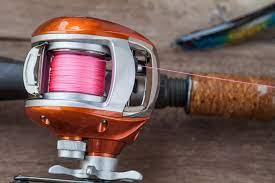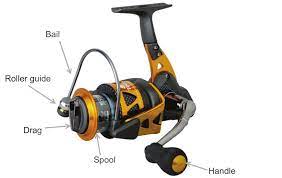How to Use a Baitcaster Reel
Are you having problems using a bait caster reel? Well, most beginners and also some experienced anglers have been finding bait caster reels hard to use. But you can beat that with a little practice.

Baitcaster reels are the best baitcasting reels over other common spinning reels due to their ability to throw heavier lures, spool heavier lines, and cast longer and more accurately.
Baitcaster fishing reels have a sheer learning curve. Thus, it requires you to learn how to fine-tune the reel’s braking system and appropriately use the thumb bar to control spool rotation during the casting process.
Important Fishing Tips on How to Use a Baitcasting Reel
- Stretch the line as you apply it to the reel to ensure it is well applied at its center. If you have a sinker attached to the line, ensure it is 6 to 12 inches from the rod tip.
- Hold the rod behind the reel with your thumb reclined over the reel spool, and it will help you gain control over the flow of the line during the cast.
- Rotate the rod, letting the reel handle face up to help you use your wrist when casting, but if you use a left-handed model, the handles should point downwards.
- Detach the release bar or press the button, bending your casting arm at right angles and raising your rod until its tip is moderately past vertical, providing the right position to cast the line.
- Lift your thumb off the reel, allowing the weight of your lure to pull the line off the spool, tossing it toward the target.
- Thumb the reel spool to stop the bait when it reaches the target, and this is like pressing the button on the spinning reel to decelerate the line. This should be done accurately to avoid an overrun, also known as a bird’s nest, which will need straightening before retrieving.
- Avoid overcasting your line, adjust your reel settings, and with enough practice, you will perfect your casting distance.
Spooling a Bait Caster Reel

- imageStart by feeding the line to the spool by running it through the guides.
- Then secure the line on the spool by tying a knot and trimming the tag end to half an inch.
- Load your line to the spool by gripping the factory spool between your feet and directing the reel towards your rod.
How to Adjust a Baitcasting Reel
After loading and securing your line to the spool, the reel will require certain adjustments for it to work properly. Those adjustments are as follows;
Setting the Spool Tension Knob
A spool tension knob is located on the handle side near the drag star to help control the amount of force needed to start the spool spinning.
Start by tying a lure or a jig of about half-inch line between your bait and the rod tip. Then tighten the tension knob before hitting the release button; hence the bait hits the ground.
If your line spills off, tighten the spool to avoid backlash. If your lure does not hit the ground, your tension knob is too tight. Adjust the knob every time you change lures to ensure the proper tension.
Setting the Brake System Adjustments
The brake system regulates the spool speed and stops popping out the line after the lure is cast. The braking system is located opposite the handle side of the reel.
Most reels will have either a centrifugal braking system, while other reels have a magnetic braking system.
Magnetic brakes work better if positioned further from the spool reel to enhance more spins. When it comes to an aluminum spool, the magnetic brake work as a conductor when the current is produced by the spool and moves along the opposing force of the magnetic field.
Most magnetic braking systems have a dial of settings 1 to 10 on the side plate opposite the handle. The dial helps increase and decrease the power of the magnetic braking system.
A magnetic setting of 5-7 is an average range of new anglers. Loosening the spool tension and lowering the breaks will allow you to cast farther and faster.
The centrifugal brake system allows the line to feed off the spool at the same speed rate as the cast. As the spool is spinning, gravity makes the centrifugal brakes extend from the center of the spool and run along a shelf inside the side panel of the reel.
You will need to remove the reel cover and identify the braking pins for the centrifugal braking system. The pins can be in the on or off position.
Setting Drag System Adjustment
A drug system is controlled by a dial between the handle and the reel. It is set by tying the line to the scale and moderately increasing the drag setting until you obtain the right weight.
When throwing a drug on a heavier cover, use a heavier line to reduce the pressure to hook the line. But when using topwater plugs, a lighter braided line is ideal for a hook set on a long cast, especially for bass fishing.
How to Choose the Right Baitcaster Reel Gear Ratio?
The fishing reel gear ratio is a set of three numbers that describes the retrieval speed rate. When choosing a baitcast reel type, it’s important to consider the type of fishing you are set for.
The most regular gear ratio ranges from 5.0:1 up to 8.5:1. The first set of numbers explains the number of turns the spool makes for every reel handle turn.
Baitcasting reels come in different gear ratios, and choosing the right one depends on the type of fishing intended for catching bass. the following are some of the common fishing ratios ;
Lower Gear Ratios
Using a lower gear ratio of 5 to 1 is appropriate for a giant bass since you will require to use big lures. A low gear ratio provides you with a higher force level that allows you to turn your handle, despite the pressure the bass puts on the reel. It also appeals to areas with heavy cover.
Higher Gear Ratios
For beginners, a 6 to 1 gear ratio is appropriate since it provides a better line control and steady fishing experience. It works well with many lures such as; spinnerbaits, jigs, and jerk baits, among others.
For a more experienced bait caster, the higher gear ratio of 7 to 1 and more is great since it can be used to make longer casts with almost all lures from buzz baits, crankbaits, and flipping jigs, light lure, spinnerbaits, and chatter baits.
Conclusion
Whether fresh or saltwater fishing, bait casters are known to be excellent to use with artificial lures since they can be used for accurate casts, they can also be used to secure large fish like bigmouth bass, catfish, and salmon.
To be an excellent bait caster, you must follow the above fishing tips to help you master your reel line faster and accurately.


